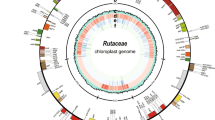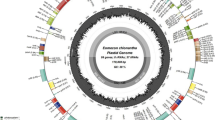Abstract
The genus Dasypyrum (or Haynaldia) consists of two species, D. villosum and D. breviaristatum. However, the genomic relationships between these two species remain unclear. The objective of this study was to provide molecular phylogenic and cytological evidence on the evolutionary relationships of the genus Dasypyrum. Sequences of Chloroplast DNA (cpDNA) and α-gliadin genes both support the hypothesis that diploid D. breviaristatum is the progenitor of tetraploid D. breviaristatum, and the diploid D. villosum and D. breviaristatum evolved parallel from an ancestral species. Genomic and fluorescence in situ hybridization using ribosomal DNA and rye repetitive DNA sequence as probes also indicated that tetraploid D. breviaristatum originated from diploid D. breviaristatum.



Similar content being viewed by others
References
Anderson OD, Litts JC, Greene FC (1997) The α-gliadin gene family. I. characterization of ten new wheat α-gliadin genomic clones, evidence for limited sequence conservation of flanking DNA, and southern analysis of the gene family. Theor Appl Genet 95:50–58
Bai LL, Yang ZJ, Liu C, Feng J, Deng KJ, Ren ZL (2007) Structural and transcriptional polymorphism of mitochondrial rrn18-trmfM region in Triticeae species. Acta Agron Sinica 33:805–813
Bedbrook JR, Jones J, O’Dell M, Thompson R, Flavell RB (1980) A molecular description of telomeric heterochromatin in Secale species. Cell 19:545–560
Blanco A, Simeone R, Resta P, De Pace C, Delre V, Caccia R, Scarascia Mugnozza GT, Frediani M, Cremonini R, Cionini PG (1996) Genomic relationships between Dasypyrum villosum (L.) Candargy and D. hordeaceum (Cosson et Durieu) Candargy. Genome 39:83–92
Chen PD, Qi LL, Zhang SZ, Liu DJ (1995) Development and molecular cytogenetic analysis of wheat-Haynaldia 6VS/6AL translocation lines specifying resistance to powdery mildew. Theor Appl Genet 91:1125–1128
De Pace C, Deler V, Scarascia Mugnozza GT, Qualset CO, Cermonini R, Frediani M, Cionini PG (1992) Molecular and chromosomal characterization of repeated and single-copy DNA sequences in the genome of Dasypyrum villosum. Hereditas 116:55–65
De Pace C, Snidaro D, Ciaffi M, Vittori D, Ciofo A, Cenci A, Tanzarella OA, Qualset CO, Scarascia Mugnozza GT (2001) Introgression of Dasypyrum villosum chromatin into common wheat improves grain protein quality. Euphytica 117:67–75
Felsenstein J (1993) PHYLIP: phylogeny inference package, version 3.5. University of Washington, Seattle, WA (http://evolution.genetics.washington.edu/phylip.html)
Frederiksen S (1991) Taxonomic studies in Dasypyrum (Poaceae). Nord J Bot 11:135–142
Galasso I, Blanco A, Katsiotis A, Pignone D, Heslop-Harrison JS (1997) Genomic organization and phylogenetic relationships in the genus Dasypyrum analyzed by Southern and in situ hybridization of total genomic and cloned DNA probes. Chromosoma 106:53–61
Gerlach WL, Bedbrook JR (1979) Cloning and characterization of ribosomal RNA genes from wheat and barley. Nucl Acids Res 7:1869–1885
Gerlach WL, Dyer TA (1980) Sequence organization of the repeating units in the nucleus of wheat which contain 5S rRNA genes. Nucleic Acids Res 8:4851–4865
Jauhar PP, Joppa LR (1996) Chromosome pairing as a tool in genome analysis: merits and limitations. In: Jauhar PP (ed) Methods of genome analysis in plants. CRC Press, Boca Raton (FL), pp 9–37
Li WL, Chen PD, Qi LL, Liu DJ (1995) Isolation, characterization and application of a species-specific repeated sequence from Haynaldia villosa. Theor Appl Genet 90:526–533
Li GR, Liu C, Zeng ZX, Jia JQ, Zhang T, Zhou JP, Ren ZL, Yang ZJ (2009) Identification of α-gliadin genes in Dasypyrum in relation to evolution and breeding. Euphytica 165:155–163
Liao JQ, Yang RW, Zhou YH, Tsujimoto H (2007) FISH analysis of 45S and 5S rDNA genes in Triticum polonicum L. and T. turgidum L. cv. Ailanmai. Hereditas 29:449–454
Linde-Laursen L, Frederiksen S (1991) Comparison of the Giemsa C-band karyotype of Dasypyrum villosum and D. breviaristatum (4×) from Greece. Hereditas 114:237–244
Liu C, Li GR, Yang ZJ, Feng J, Zhou JP, Ren ZL (2006a) Isolation and application of specific DNA segment of rye genome. Acta Bot Boreal Occident Sin 26:2434–2438
Liu C, Yang ZJ, Li GR, Feng J, Deng KJ, Huang J, Ren ZL (2006b) Sequence variation of chloroplast gene infA-rp136 region occurred in some Triticeae species. Hereditas 28:1265–1272
Liu C, Li GR, Yang ZJ, Feng J, Zhou JP, Ren ZL (2007) A discussion on genetic relationship in genome between Thinopyrum and Dasypyrum. High Technol Lett 17:295–300
Löve A (1984) Conspectus of the triticeae. Feddes Rep 95:425–521
Millen RS, Olmstead RG, Adams KL, Palmer JD, Lao NT, Heggie L, Kavanagh TA, Hibberd JM, Gray JC, Morden CW, Calie PJ, Jermiin LS, Wolfe KH (2001) Many parallel losses of infA form chloroplast DNA during angiosperm evolution with multiple independent transfers to the nucleus. Plant Cell 13:645–658
Moore G, Devos KM, Wang Z, Gale MD (1995) Grass, line up and form a circle. Curr Biol 7:737–739
Murray TD, De la Pena RC, Yildirim A, Jones SS (1994) A new source of resistance to Pseudocercosporella herpotrichoides cause of eyespot disease of wheat located on chromosome 4 V of Dasypyrum villosum. Plant Breed 113:281–286
Ogihara Y, Yamazaki Y, Murai K, Kanno A, Terachi T, Shiina T, Miyashita N, Nasuda S, Nakamura C, Mori N, Takumi S, Murata N, Futo S, Tsunewaki K (2005) Structural dynamics of cereal mitochondrial genomes as revealed by complete nucleotide sequencing of the wheat mitochondrial genome. Nucl Acids Res 33:6235–6250
Ohta S, Morishita M (2001) Genome relationships in the genus Dasypyrum (Gramineae). Hereditas 135:101–110
Ohta S, Zine Elabidine F, Morikawa I, Tominaga T, Mellas H, Furuta Y (1997) Report on a cooperative cereal germplasm collection mission in Morocco. Al Awamia 97:51–64
Ohta S, Koto M, Osada T, Matsuyama A, Furuta Y (2002) Rediscovery of a diploid cytotype of Dasypyrum breviaristatum in Morocco. Genet Res Crop Evol 49:305–312
Sando WJ (1935) Intergeneric hybrids of Triticum and Secale with Haynaldia villosa. J Agric Res 51:579–800
Sarkar P (1957) A new diploid form of Haynaldia hordeacea Hack. Wheat Inf Serv 6:22
Tamura K, Dudley J, Nei M, Kumar S (2007) MEGA4: molecular evolutionary genetics analysis (MEGA) software version 4.0. Mol Biol Evol 24:1596–1599
Thompson JD, Higgins DG, Gibson TJ (1994) CLUSTAL W: improving the sensitivity of progressive multiple sequence alignment through sequence weighting, position-specific gap penalties and weight matrix choice. Nucl Acids Res 22:4673–4680
Uslu E, Miller TE, Rezanoor NA, Nicholson PN (1998) Resistance of Dasypyrum villosum to the cereal eyespot pathogens, Tapesia yallundae and Tapesia acuformis. Euphytica 103:203–209
Uslu E, Reader SM, Miller TE (1999) Characterization of Dasypyrum villosum (L.) Candargy chromosomes by fluorescent in situ hybridization. Hereditas 131:129–134
van Herpen TW, Goryunova SV, van der Schoot J, Mitreva M, Salentijn E, Vorst O, Schenk MF, van Veelen PA, Koning F, van Soest LJ, Vosman B, Bosch D, Hamer RJ, Gilissen LJ, Smulders MJ (2006) Alpha-gliadin genes from the A, B, and D genomes of wheat contain different sets of celiac disease epitopes. BMC Genomics 7:1–13
von Bothmer R, Claesson L (1990) Production and meiotic pairing of intergenetic hybrids of Triticum × Dasypyrum species. Euphytica 51:109–117
Wilson J (2009) Production of wheat-Haynaldia villosa Robertsonian chromosomal translocations, MS Thesis, Department of Plant Pathology, Kansas State University, 49 pp
Xu CM, Bie TD, Wang CM, Zhou B, Chen PD (2007) Distribution of 45S rDNA sequence on chromosomes of Triticum aestivum and its relative species. Hereditas 29:1126–1130
Yang ZJ, Feng J, Zhou JP, Liu C, Ren ZL (2005) Identification of Dasypyrum breviaristatum chromatin in wheat background by in situ hybridization. Southwest China J Agric Sci 18:608–611
Yang ZJ, Liu C, Feng J, Li GR, Zhou JP, Deng KJ, Ren ZL (2006) Studies on genomic relationship and speciWc marker of Dasypyrum breviaristatum in Triticeae. Hereditas 143:47–54
Yang ZJ, Zhang T, Liu C, Li GR, Zhou JP, Zhang Y, Ren ZL (2008) Identification of wheat-Dasypyrum breviaristatum addition lines with stripe rust resistance using C-banding and genomic in situ hybridization. In: Appels R, Eastwood E, Lagudah E, Langridge P, Mackay M (eds) Proceedings of 11th international wheat genet symposium, Sydney University Press. http://ses.library.usyd.edu.au/handle/2123/3272
Yildirim A, Jones SS, Murray TD (1998) Mapping a gene conferring resistance to Pseudocercosporella herpotrichoides on chromosome 4 V of Dasypyrum in a wheat background. Genome 41:1–6
Yuan WY, Tomita M (2009) Centromeric distribution of 350-family in Dasypyrum villosum and its application to identifying Dasypyrum chromatin in the wheat genome. Hereditas 146:58–66
Zhang P, Friebe B, Lukaszewski AJ, Gill BS (2001) The centromere structure in Robertsonian wheat-rye translocation chromosomes indicates that centric breakage-fusion can occur at different positions within the primary constriction. Chromosoma 110:335–344
Zhang P, Friebe B, Gill BS (2002) Variation in the distribution of a genome-specific DNA sequence on chromosomes reveals evolutionary relationships in the Triticum and Aegilops complex. Plant Syst Evol 235:169–179
Zhang QP, Li Q, Wang XE, Lang SP, Wang YN, Wang SL, Chen PD, Liu DJ (2005) Development and characterization of a Triticum aestivum-Haynaldia villosa translocation line T4VS.4DL conferring resistance to wheat spindle streak mosaic virus. Euphytica 145:317–320
Acknowledgments
We thank the National Natural Science Foundation of China (No. 30671288, 30871518) and Chinese Ministry of Education (NCET-06-0810) for financial support. We particularly thank Dr. Shoji Ohta, W. Jon Raupp and the NPGS for kindly providing seeds. This research was also supported by grants from the Kansas Wheat Commission and the Kansas Crop Improvement Association. This paper is contribution no. 10-267-J from the Kansas Agricultural Experiment Station, Kansas State University, Manhattan, Kansas, 66506-5502.
Author information
Authors and Affiliations
Corresponding author
Additional information
C. Liu and G.-R. Li contributed equally to this paper.
Rights and permissions
About this article
Cite this article
Liu, C., Li, GR., Sehgal, S.K. et al. Genome relationships in the genus Dasypyrum: evidence from molecular phylogenetic analysis and in situ hybridization. Plant Syst Evol 288, 149–156 (2010). https://doi.org/10.1007/s00606-010-0319-9
Received:
Accepted:
Published:
Issue Date:
DOI: https://doi.org/10.1007/s00606-010-0319-9




